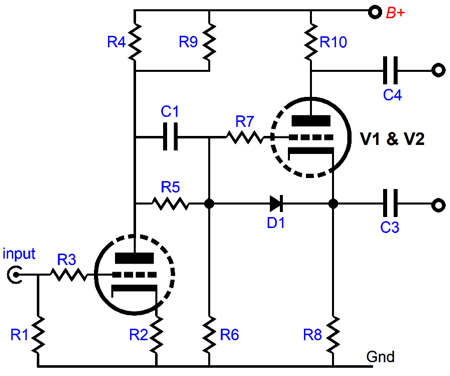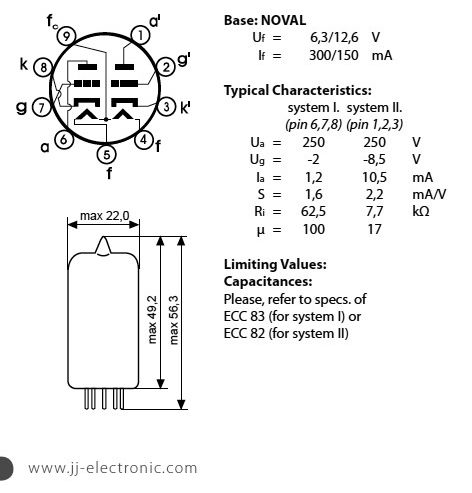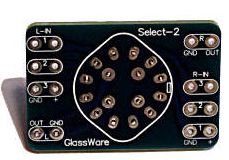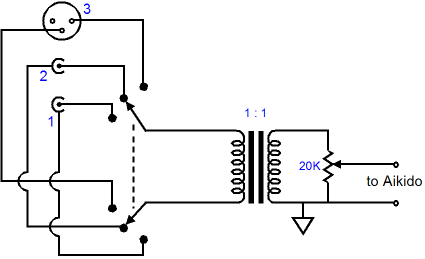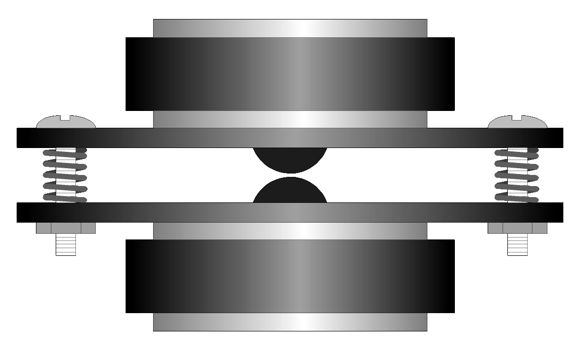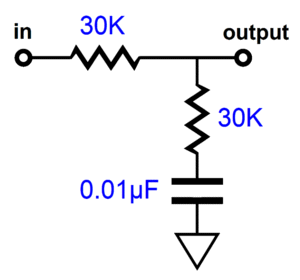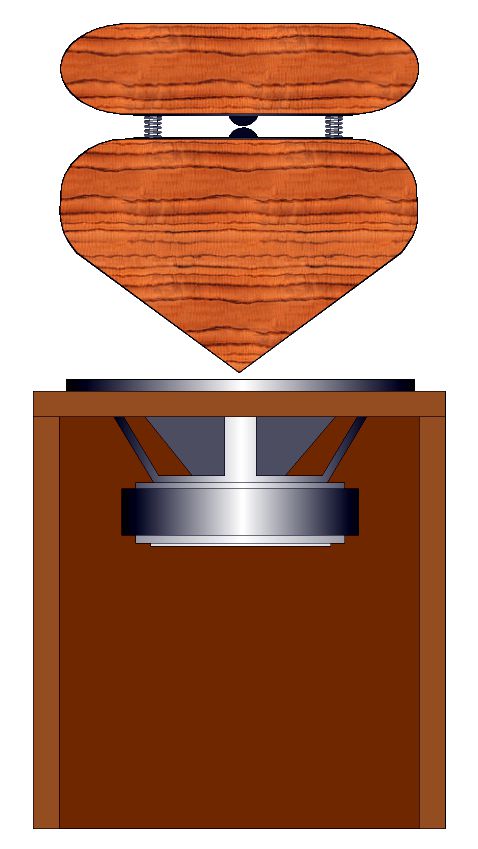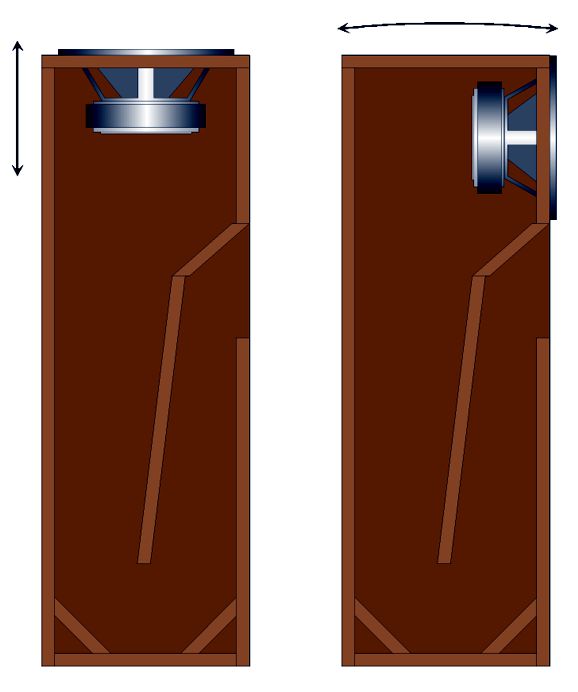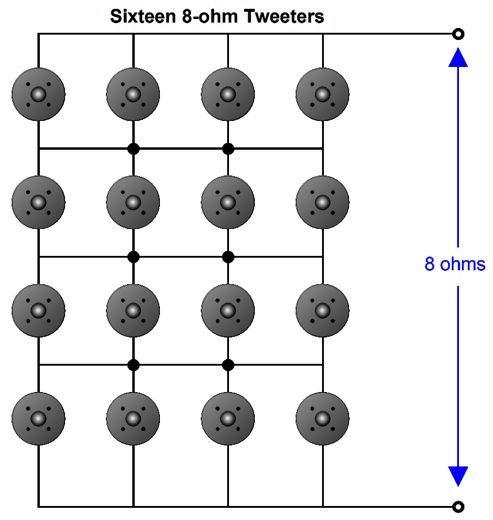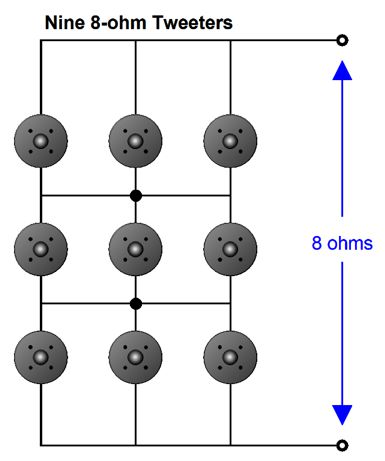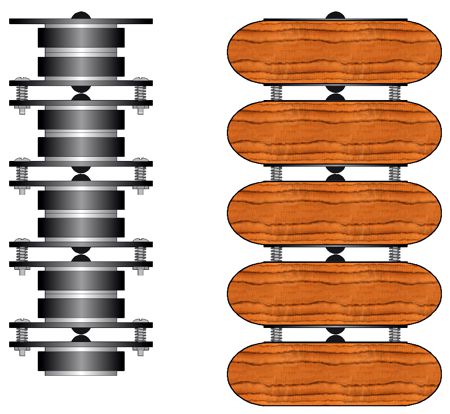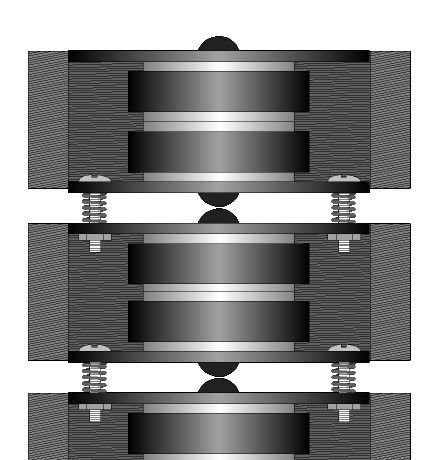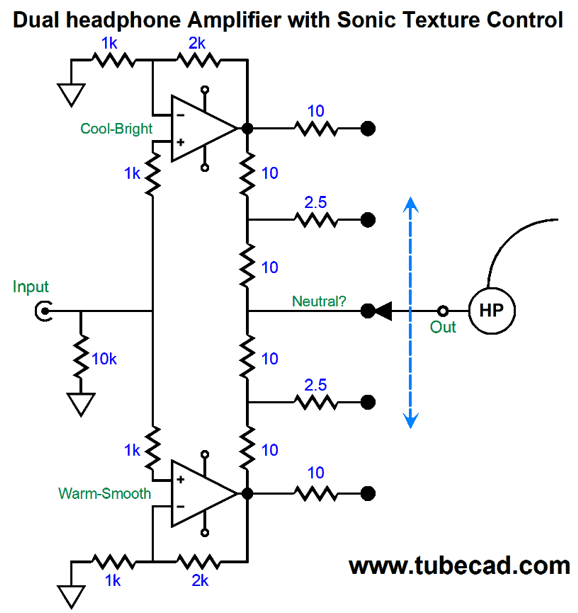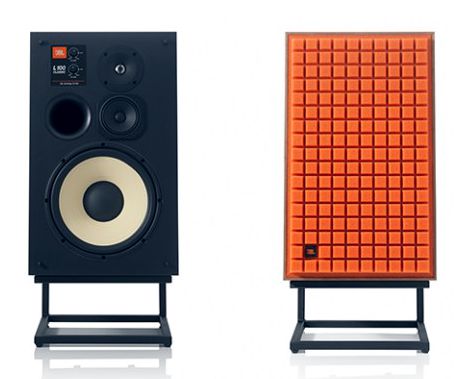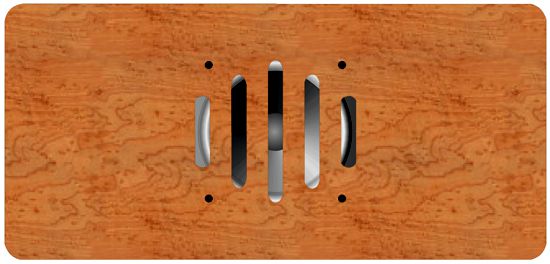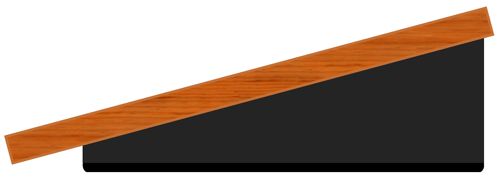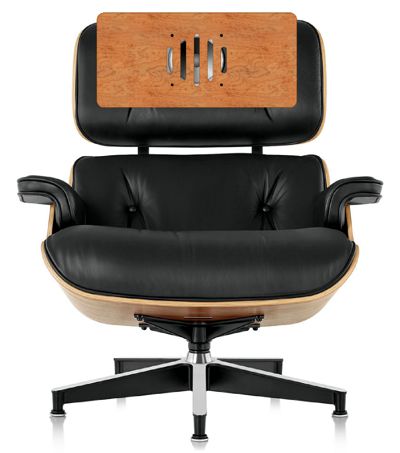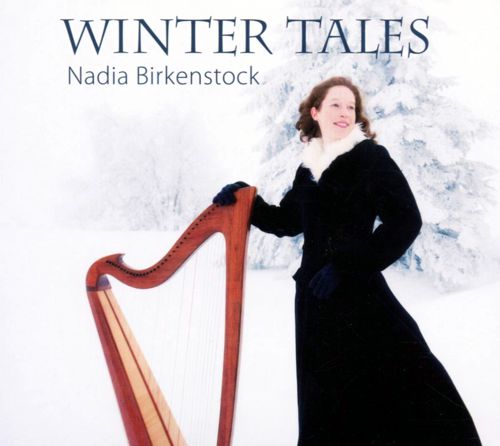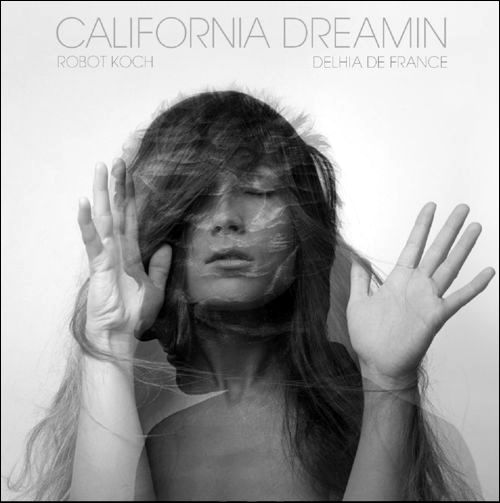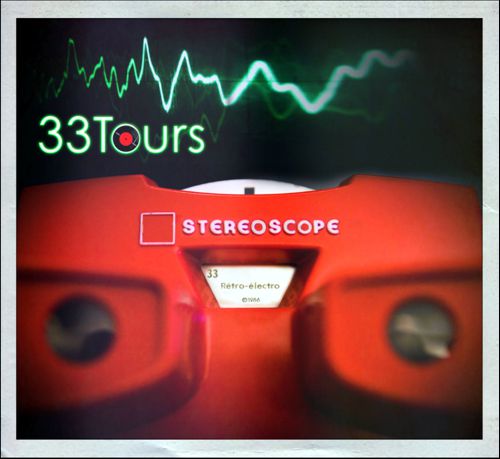| John Broskie's Guide to Tube Circuit Analysis & Design |
30 December 2018 Post Number 451
Happy New Year
Balancer Update
Since the split-load phase splitter only has to present its two outputs signals to the following two cathode follower grids, high-current is not required, as the 12AX7 doesn't in any real sense power anything.
How did it sound? The previous input tube was a 12AU7, so the only real change was the split-load phase splitter triode and the higher ohmage power-supply and phase-splitter cathode and plate resistors. So I wasn't surprised that it sounded the same as before, which was good. One reader asked why didn't I make a Balanced, not a Balancer. In other words, why didn't I make it fully balanced, both input and output? I could have easily, but I see balancer already offering that possibility with the addition of an input transformer. Here is the amazingly cool aspect of an input signal transformer: it can accept both unbalanced and balanced input signals. No problem. In fact, it sidesteps problems, such as grounding issues which no active circuit could hope to match.
All that is needed, in addition, to the two input transformers is a GlassWare Select-2 selector switch, as it switches both the hot and cold connections to each of the three signal sources.
With the input transformer, we choose between unbalanced and balanced signal sources. And by using both RCA output jacks and XLR jacks, we drive either a balanced or unbalanced power amplifier. Of course, with a fully balanced line-stage amplifier and the same two input transformers, we could do the same. The important difference is that the Balancer does not require the input transformers when all the signal sources are unbalanced.
Opposed Tweeters
I tried this setup with fabric and metal dome tweeters. My favorites were the 4-ohm version of the Audax HD100 D25. Using two in series brought the impedance up to 8 ohms and doubled the tweeter's maximum power handling. (The 4-ohm versions sounded far more agile than their 8-ohm brothers, but they did burn out far more readily.) I had built a 42-inch tall 9-inch square folded transmission-line enclosure for a 5-inch woofer. With the 360-degree tweeter atop the box, the sound was fantastically 3D, with near field listening particularly sweet. (I had to include a bass-diffraction-loss bass boost circuit before the power amplifiers, starting at 400Hz and ending at 200Hz.)
My goal was to build a two-way with the woofer firing upwards.
A wood lathe would be needed to create the top and bottom wood structures. Note how the top and bottom wood structures form a 360-degre horn of sorts—or, if you prefer, call it a wave guide. By the way, one huge advantage to having the woofer fire up in a tall, narrow enclosure is that the cone's motion will have to fight the entire enclosure mass to get it to move up and down. In contrast, placing the the woofer on the front of the tall speaker enclosure allows the speaker to rock back and forth, which is far easier.
Well, I have been tempted to try the two opposed tweeter technique again, but with an essential difference. One huge advantage to fullrange loudspeaker, either the electrostatic or dynamic type, is that they sidestep the the problem of sound lobing caused by the interaction of two distant sound-emitting sources. Ideally, we would want no more spacing between two loudspeaker driver centers than one quarter the length of the crossover frequency's wavelength. How do we find at length? Simple, we take 13536 and divide it by four times the crossover frequency. For example, if the crossover frequency is 500Hz, then 13536/(500 x 4) = 6.77 inches or 172mm. Not much spacing is it? Thus, you can see the great advantage to co-axial drivers that place the tweeter at the center of the woofer cone. In addition, you can see at least one advantage that steep 24dB-per-octave crossovers bestow is much less frequency overlap between drivers. In contrast, a first-order (6dB per-octave) crossover produces a huge overlap. At the same time, only the first-order crossover that can deliver flat phase response. Hands down, the first-order crossover is best, but only if the drivers are up to it—much like democracy and a simple food dish, as both require the best components. When Hannibal Barca, the great general of the Phoenician state of Ancient Carthage, asked what the Roman Senate was like, he assumed that it was only a bunch of senile gents. He was corrected and told that it was more like an assembly of great kings. Okay, let's return to the two tweeters in an oppositional arrangement. The two domes almost touch and, relative to our ears, they are in the exact same vertical line. Well, what if we place a crossover frequency between the two dome tweeters, so one tweeter handles the lower highs, while its mate handles the upper highs? For example, if the crossover frequency between woofer and tweeter is 4kHz, we would use 9kHz between the two identical tweeters, as 9kHz is the geometric mean frequency between 4kHz and 20kHz. We find this frequency by taking the square-root of the product of 4k against 20k. (If the first crossover frequency was 5Khz, the math would be obvious, as 5k doubled becomes 10k—the second crossover frequency—which then doubles to 20k, or put mathematically, √(5k x 20k) = 10k.) Another idea that comes to mind is that we could stack four tweeter pairs, making a total of eight dome tweeters and a fairly tall vertical 360-degree sound source. If we were supremely ambitious, we could use 16 dome tweeters. Why? If nothing else we would get back to 8-ohms with sixteen 8-ohm tweeters. In addition, with the vastly increased surface area, we could lower the crossover frequency, say to 2kHz, assuming that all the tweeters extend up to 20kHz and that their resonant frequency was below 1kHz; one crossover frequency, in other words. Basically, every fourfold increase in driver area allows us to halve the low-frequency cutoff frequency. An active crossover with an 18dB or 24dB crossover slope would also help keep the tweeters out of trouble.
The SPL per watt of power would go way up. With 16 dome tweeters, we gain +24dB of efficiency due to the sixteen-fold increase in emitting surface area, but we lose 12dB due to each tweeter only seeing one fourth of the amplifier voltage, yielding a total increase of +12dB, so nominally 92dB tweeters would become a 104dB at 1 watt at 1 meter tweeter column. In other words, a flea-power tube amplifier would work just fine at powering the tweeters. (A safety coupling capacitor would still be needed, as a loose ground connection could easily provoke full output at 60Hz, blowing our 16 tweeter up. A 30µF capacitor in series with the amplifier's output should do the trick.)
The last tweeter will not find a partner, so it fires upward.
The SPL goes up by 9.5dB in this arrangement relative to a single tweeter. On the right we see the wood donuts. Another possibility would be to make short pipes out of half-inch thick felt, just tall enough to cover the two magnet structures and two tweeter face-plates, so as the 360-degree wave-front emerges from the tweeters, it would encounter a softer transition from the confines of the two face-plate to the free air.
How would the wiring be connected? We could drill a hole through the center of the metal bolts. Or, if the tweeter faceplate is made of plastic, we could use brass bolts and pass the signal through them.
Sonic Control for Headphone Listening Which sonic signature is best? Is a foolish question. Which are more attractive, blondes, brunettes, or redheads? Which is better, red wine or white wine? It depends on what you plan on serving to eat with it. (By the way, the best match for hamburgers is champagne. Don't believe me? Try it. You will find that the champagne cuts through the heaviness and grease quite well.) Each music recording will find a preferred matching. A recording from the 1970s and Germany might sound vastly better with a drastically different sonic signature than a recording from America in the 1950s. Indeed, as our mood alters or the musical genre changes, we might flip our preferences. Wouldn't this same argument hold true for loudspeaker and power amplifiers? Yes. The big problem with loudspeakers is the hassle of switching amplifiers and interconnect connections. In contrast, headphones are designed to plug into jacks and headphone amplifiers are small and cheap, at least solid-state headphone amplifiers are. In short, I am advocating that we build a headphone amplifier that holds two stereo amplifiers, which present opposed sonic signatures, but use one enclosure and one power supply. We could use two headphone jacks, but what I have in mind is more devious: a sonic blend control and a single headphone jack.
Only one channel is shown. The top solid-state amplifier might be based on an Analog Devices (or Linear Technologies) OpAmp and metal-film resistors, while the bottom amplifier might hold a Burr-Brown OpAmp and carbon-film (or carbon-composition) resistors. In other words, we would purposely strive for obtaining polar opposites in sonic flavor. The rotary switch provides five positions. At either extreme we get 100% of one sonic signature. But as we move to the center, we get a blend, with the center-most position delivering a 50-50 blend. At all positions, the headphones see the same 10-ohm output impedance (plus whatever intrinsic OpAmp output impedance appears, which isn't much with high-current OpAmps.) What interests me most is what the sound would be like at the center position. Would it be neutral or a new, third flavor? (If you mentally flexible enough, try imagining four different-sounding amplifiers per channel, and two rotary switches, so we could make sonic adjustments across the X and Y axes.) By the way, we could place another two-pole rotary switch (or dual linear potentiometer) in series with the two channel outputs, which would allow us to vary the output impedance and, thus, the damping factor, which would alter the bass character. In addition, we could add a stereo-mono blend control. In general, we get far too much stereo separation with headphone listening, so some blending is always welcome. One of my Tilt Controls wouldn't hurt either. Moreover, since many suffer from hearing imbalances between ears, a balance control might prove essential.
So what is not to like here? The answer depends on what type of audiophile you are. If you are the bold and confident type, the master of your fate, the captain of your soul, the lord of your stereo system, then all of the above would be welcomed enthusiastically. On the other hand, if you are closer to the type best liked by high-end audio companies, pusillanimous and neurotic, then being put behind the steering-wheel is the last thing you will desire. What if you make a mistake? What if others harshly judged your taste? No, it's so much much better to leave our preferences to the experts who work for the glossy audio magazines and audio salons to set us straight and vouchsafe our critical listening, leaving us secure from onerous judgment and heavy responsibility.
I recently saw an ad from JBL that showcased their revival of the old classic L100. Although I wasn't a fan of the loudspeaker back in the 1970s, I heartily welcome its return, replete with the orange foam grill. (I remember being told by an audiophile that the L100 was the last loudspeaker he enjoyed owning; but since his fellow audiophile friends looked down on them, he replaced the pair with a long series of loudspeakers that he didn't like as much. The American Psychiatric Association informs us that nearly one in five (19%) suffers from some form of mental illness. No doubt that if they had included more audiophiles in their sample population, we would easily hit the full 20%.) They're your ears; make them happy anyway you can. The obvious question is. Since we are striving for polar opposite sonic signatures, why isn't one of the two headphone amplifiers a tube-based one? The answer is that the two amplifiers could no longer share the same power supply and I fear phase shifts from either the coupling capacitor or the output transformer used to couple the tube circuit to the headphones. If the phase shifts too far apart, the blending will not work as intended. Of course, if the solid-state amplifier were capacitor coupled, we would have a lot less to worry about, as we could use the same valued coupling capacitor in both amplifiers. We would still have the problem of dissimilar output impedances, but we could pad the solid-state amplifier output with a series resistor. No doubt, we would need to teak the gains to get a perfect match. In other words, much more work.
A New Audio Product Category Back in post number 278, I wrote the following:
Okay, so what new audio product is possible? A good place to start looking is at where a present problem exists. Problems give birth to new products; other than being an oppressive and soul-damaging force in the lives of those who overly frequent coffee shops, the great over-schooled and under-educated class, what is capitalism but a problem solving machine? One problem we encounter with headphone listening is that the bass falls short of reality—or of what good loudspeakers can deliver. The famous Beats headphones are popular because they do deliver bass, lots of it, big, fat, and sassy. But we pay a high price for bass-intense headphones, as they lack delicacy and refinement. The workaround I came up with in the late 1970s was to use a 300lbs subwoofer with my Sennheiser HD414 headphones. Alas, this solution was neither cheap nor portable. A better solution would be a HeadWoofer™ that would provide the missing somatosensorial bass we long for, yet be easy to carry. All that is needed is a sheet of plywood (marine-grade) roughly the size of a pillow, with low-profile woofer, the type used in car stereo systems and class-D power amplifier and BlueTooth receiver (or input jack) and rechargeable battery. (No doubt a planar driver, such as used in the Magneplanar loudspeaker and HiFiMan headphones could be used.) Surely, each of you owns a BlueTooth portable speaker that runs off batteries. Well, this subwoofer for headphone listening would be quite similar.
We would place the Headwoofer atop our bed or sofa and place a pillow on top, plug in our headphones or turn on BlueTooth connections, and listen away. With our head just inches away from the woofer, not much power would be needed. In fact, with our head resting on the woofer's center, we could use a dipole enclosure, as the bass cancellation would occur at the ends, away from our ears. In fact, we could enclose a quality headphone amplifier in the HeadWoofer. The single (or dual) woofer(s) would only need to extend up to 100Hz and we could implement bass boosts and phase reversals as desired. Here is a side view that shows two triangular legs, with thick felt bottoms.
The first headwoofers would cost $1,000 to $2,000, so as to recoup development costs and to give the rich something to play with and boast about. But soon enough injected-molded plastic would replace the wood panel and the cost would fall to $50 to $300, with a special high-end-audio version available for a mere $10,000, which would be deemed a bargain, considering the eight 300B tubes it held. We could use the headWoofer with a chair. All that would be needed is a pair of adjustable hooks and a flat pillow to cover the HeadWoofer.
I actually came up with this idea twenty years ago and I only returned to it last night. I was in bed, listening to Mahler's 3rd Symphony, with quality earbuds; and I longed for deep, articulate bass, as majestic music requires matching majestic sound.
Music Recommendation: Nadia Berkenstock's Winter Tales Speaking of German singers, I recently discovered Delhia de France.
Alas, Tidal only offers a few of her songs. One I particularly enjoyed was her cover of the song made famous by The Mamas & the Papas, California Dreamin', with Robot Koch. Due to Tidal's lame database programming, you won't find this track under her name; instead, you must type in "Robot Koch, Delhia de France" in the search field.
Although not German (but from Québec, Canada, I believe), I found the cover of this classic song by 33Tours* (Jérôme Boisvert, Myriam Labbé, and Catherine Sawyer) on their Stereoscope album compelling. Indeed, the entire album is interesting. In addition, give their cover of the famous Led Zeppelin song, Kashmir, a good listen and see if you, too, do not become a fan of Retro-Électro music.
You did note the oscilloscope traces and the LP inside the "O" and that in French an LP is a disque 33 tours, right? So much great music, so little time. //JRB
*33Tours
"33Tours est un groupe de musique de style Retro-Électro qui s'inspire des grands succès qui ont marqué la musique à l'époque des vinyles, mais les transforme avec les sonorités qui influcent la musique d'aujourd'hui."
If you enjoyed reading this post from me, then you might consider becoming one of my patrons at Patreon.com
User Guides for GlassWare Software
For those of you who still have old computers running Windows XP (32-bit) or any other Windows 32-bit OS, I have setup the download availability of my old old standards: Tube CAD, SE Amp CAD, and Audio Gadgets. The downloads are at the GlassWare-Yahoo store and the price is only $9.95 for each program. http://glass-ware.stores.yahoo.net/adsoffromgla.html So many have asked that I had to do it. WARNING: THESE THREE PROGRAMS WILL NOT RUN UNDER VISTA 64-Bit or WINDOWS 7 & 8 or any other 64-bit OS. I do plan on remaking all of these programs into 64-bit versions, but it will be a huge ordeal, as programming requires vast chunks of noise-free time, something very rare with children running about. Ideally, I would love to come out with versions that run on iPads and Android-OS tablets. //JRB |
John Gives
Special Thanks to the Special 73
I am truly stunned and appreciative of their support. In addition I want to thank
All of your support makes a big difference. I would love to arrive at the point where creating my posts was my top priority of the day, not something that I have to steal time from other obligations to do. The more support I get, the higher up these posts move up in deserving attention. Only those who have produced a technical white paper or written an article on electronics know just how much time and effort is required to produce one of my posts, as novel circuits must be created, SPICE simulations must be run, schematics must be drawn, and thousands of words must be written. If you have been reading my posts, you know that my lifetime goal is reaching post number one thousand. I have 549 more to go. My second goal is to gather 1,000 patrons. I have 927 patrons to go. Help me get there.
Support the Tube CAD Journal & get an extremely powerful push-pull tube-amplifier simulator for TCJ Push-Pull Calculator
TCJ PPC Version 2 Improvements Rebuilt simulation engine *User definable
Download or CD ROM For more information, please visit our Web site : To purchase, please visit our Yahoo Store: |
|||
| www.tubecad.com Copyright © 1999-2018 GlassWare All Rights Reserved |

